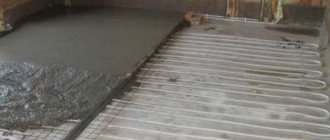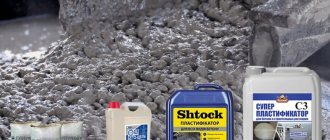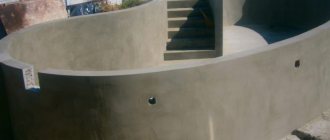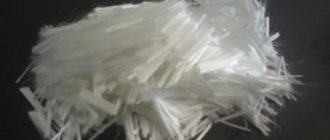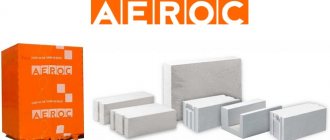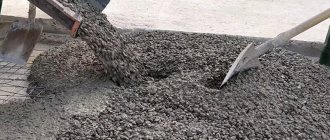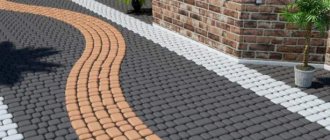Beton-House.com
Website about concrete: construction, characteristics, design. We combine the experience of professionals and private craftsmen in one place
Plasticizers for concrete mortar
A plasticizer for concrete is a special chemical additive that is added to the mixture in order to improve a whole range of physical and mechanical characteristics of the material. Plasticizing additives make it possible to obtain a significant technical and economic effect and increase the durability of structures erected from both monolithic and prefabricated reinforced concrete (see video in this article).
What is a plasticizer?
A plasticizer is a special additive for concrete that provides additional plasticity of the solution, its fluidity and mobility.
The scope of concrete is so wide that it covers all areas of construction, from residential high-rise buildings to bridges and dams. Structures are often exposed to sudden changes in temperature and humidity and must withstand any atmospheric conditions. The construction process itself also undergoes different weather conditions: heat, rain or frost. It is important that the quality of the concrete composition ensures the strength of the structures. This is facilitated by the use of additives.
Air grabbers
During the manufacturing process of concrete, air enters the solution mass. Remaining inside, after hydration, a porous monolith is obtained, which will have reduced strength. This is why previously the mortar poured into the mold was vibrated and compacted. Today this is not necessary if a plasticizer of this type is added.
Its main property is that it breaks the air into small bubbles that do not change the density of the mixture. As moisture penetrates into the concrete body, water accumulates in the bubbles. There it expands at low temperatures without disturbing the structure of the hardened concrete itself.
Why do you need a plasticizer?
Concrete in liquid form is often needed for construction purposes. It is convenient to use for pouring formwork and other narrow elements. The high density of concrete does not allow its full use. And the liquefaction of concrete with water changes its physical characteristics, reduces the strength of the structure and its service life. Therefore, special substances – plasticizers – are used as a concrete softener.
A plasticizer is an additive to concrete and cement mortars that increases the fluidity and plasticity of the mixture.
The plasticizer improves the following quality indicators of concrete:
- Fluidity. Concrete itself is inactive and has voids in its structure. The mixture increases the mobility of the solution.
- Reduces vapor permeability, water permeability and improves frost resistance.
- Strength and quick adhesion of joints.
- Increases the service life of ready-mixed concrete.
Accelerators
These additives are added to the solution when there is a need to speed up the process of cement hydration. An example is usually given of how this plasticizer works when filling a pool. It is actually indicative, because the construction technology is standard: the bottom of the pool is poured with concrete, it must dry and gain brand strength, which takes 28 days, and only then the walls are poured into the formwork. Adding an accelerator plasticizer makes it possible to significantly reduce the construction time of a pool.
The same substances are added when using the solution in winter, when chemical processes in the mixture slow down. And this leads to a decrease in the quality of the characteristics of the finished structure. That is, having a plasticizer accelerator, you can safely engage in construction without looking at the weather forecast. Let us add that with the use of this composition the pace of construction has increased sharply.
In what quantities is plasticizer added to the cement screed composition?
The mixtures are used not only in concrete, but also in other building mixtures. They are widely used in mortars for tiles and screeds on heated floors. This mixture allows you to get a smooth surface with less time and effort. The homogeneous structure of the solution and the absence of air bubbles simplifies the process of screeding the floor.
The water-cement ratio directly affects the final quality and strength of mortars and concretes
Now the use of plasticizers has become so popular that a wide range of plasticizers with different compositions and concentrations have appeared on the building materials market. Each manufacturer indicates how much solution must be added to the finished mixture to obtain its best consistency. Typically, the mass fraction of plasticizer in the finished building mixture is 0.15-0.3%.
Appearance
Plasticizer C-3 is a dark brown liquid or light brown powder.
The powder is sold in 25 kg bags, and the liquid is sold in 0.5 liter plastic bottles. Which one to buy depends on how long it will be used. If it is necessary to store a substance for a long time, then preference should be given to a powdered plasticizer - it can be stored for a long time, but only on condition that moisture does not get into it.
Liquid plasticizer S-3 is more suitable for the construction of small structures, when you need to prepare a small amount of solution for work.
Plasticizing additives and screed for heated floors
The installation of a heated floor is necessarily accompanied by pouring a screed. Plasticizer must be added to the mixture used.
Depending on the conditions under which the base for a heated floor is poured, the additive can change different properties of the mixture:
The dosage of plasticizer is different for each manufacturer, it depends on the concentration of each individual product
- Accelerate hardening. In conditions of low temperature, the hardening process of the floor screed slows down, so it is advisable to introduce additives into it that accelerate this process.
- Slow down hydration. If it is necessary to increase the service life of the finished building mixture, then additives are introduced into it to slow down the hardening process.
- Improve mechanical properties.
- Improve thermophysical properties.
- Allows you to create a floor screed with a minimum coating thickness.
Available plasticizer replacement options
Typically, plasticizers are offered by the manufacturer in the form of a ready-made mixture, which can be purchased at any hardware store. At the same time, many available materials have the same properties that are in this additive. It is possible to prepare your own mortar using household plasticizers.
It is possible to increase the resistance of the building mixture to different types of loads using:
- Liquid soap, shampoo or dish detergent. Adding liquid soap extends the hardening time of the concrete mixture. This is relevant for long-term transportation of the finished solution or long-term pouring of complex elements with concrete.
- Slaked lime. Its addition to the solution improves its plasticity. In addition, slaked lime has bactericidal properties.
- PVA glue. A solution with the addition of glue has high waterproofing properties and increased strength.
Liquid soap can be added to the concrete solution.
The use of improvised means is possible only if an industrial plasticizer is not available for use. It is important to maintain the required proportion of substances. In addition, if the solution is created with your own hands, you need to take into account the properties of the components of the mixture, the possibility of their combination and other factors.
Content
- 1 For polymers 1.1 Mechanism of action
- 1.2 Choice
- 1.3 Anti-plasticizers
- 1.4 Safety and toxicity
- 1.5 Conventional polymer plasticizers 1.5.1 Esters of dicarboxylic/tricarboxylic acids
- 1.5.2 Trimellitates
- 1.5.3 Adipates, sebacates, maleates
- 1.5.4 Biologically based
- 1.5.5 Other plasticizers
- 2.1 Specific
Recommendations for use
Each construction site has its own characteristics, where it is necessary to take into account the complexity of the structures, the height of the building, and climatic conditions during the construction phase and during operation. Any building mixture has its own purpose and must be used under certain conditions.
When using plasticizers, you need to know that each of them performs its functions. Therefore, at the time of selection, it is necessary to study the instructions for use and follow the manufacturer’s dosage recommendations. If you plan to build a house in winter, then the product should reduce the freezing point of the water included in the concrete mixture. At negative air temperatures, adding plasticizer to the solution may not be enough to ensure uniform hardening of the mixture. In this case, you can heat the concrete with a welding machine.
All types of foundations are made using plasticizers; they strengthen the structure of the building’s base. The basement floor of a private house has direct contact with the ground, and therefore must have high waterproofing properties. It is for this purpose that plasticizer additives are always introduced into the cement mortar of the basement floor.
If you plan to build with your own hands, then it is useful to independently study blogs about what mortar is needed for laying bricks and how to crochet reinforcement. There are some rules that will help you avoid common mistakes in construction. One of them is incorrectly installed plastic windows. Errors are not visible at the installation stage. They become noticeable when windows are used at sub-zero temperatures. Condensation appears on the glass, the windows allow cold air into the room.
Insulating plastic windows will help correct installation errors, which you can read about in detail on our website.
For polymers
Plasticizers for polymers are low volatility liquids or solids. As of 2022, the total global plasticizers market was 7.5 million metric tons.
Use of plasticizers in Europe and the world by type 2017
In North America, the 2022 volume was ~1.01 million metric tons, and in Europe, 1.35 million metric tons, split among various end-use applications, with a chemical type trend toward higher molecular weight (HMW) orthophthalates and alternatives types in accordance with regulatory requirements. in relation to lower molecular weight (LMW) orthophthalates.
Plasticizer Use in Europe, 2022 Plasticizer Market Trends in Europe, 2022
Nearly 90% of polymer plasticizers, most commonly phthalate esters, are used in PVC, giving the material increased flexibility and durability.[1] Most are used in films and cables.[2]
Mechanism of action
Plasticizers were generally thought to work by inserting themselves between polymer chains, spreading them apart (increasing "free volume"),[3][4] or swelling them, which significantly reduced the glass transition temperature of the plastic and its softness; however, it was later shown that the free volume explanation cannot account for all plasticization effects.[5] The classical picture of the mobility of a polymer chain in the presence of a plasticizer is more complex than that drawn by Fox and Flory for a simple polymer chain. The plasticizer molecules control chain mobility, and there is no increase in free volume around the ends of the polymer in the polymer chain; in the case where the plasticizer/water creates hydrogen bonds with the hydrophilic parts of the polymer, the bound free volume can be reduced. [6] For plastics such as PVC, the more plasticizer added, the lower their cold bending temperature will be. Plastic products containing plasticizers may exhibit increased flexibility and durability. Plasticizers can become exposed due to migration and abrasion of the plastic since they are not bound to the polymer matrix. “new car smell” is often associated with plasticizers or their degradation products.[7] However, numerous odor composition studies have not found phthalates in appreciable quantities, likely due to their extremely low volatility and vapor pressure.[8]
The effect of plasticizers on the elastic modulus depends on both temperature and plasticizer concentration. Below a certain concentration, called the crossover concentration, the plasticizer can increase the elastic modulus of the material. However, the glass transition temperature of the material will decrease at all concentrations. In addition to crossover concentration, there is crossover temperature. Below the transition temperature, the plasticizer also increases the elastic modulus.
Migration of plasticizers from the base plastic results in loss of flexibility, brittleness and cracking. This decades-old plastic lamp cord crumbles when bent due to loss of plasticizer.
Choice
Over the past 60 years, more than 30,000 different substances have been evaluated for their suitability as polymer plasticizers. Of these, only a small number—approximately 50—are used commercially today.[9]
Ester plasticizers are selected based on cost-effectiveness assessments. The rubber compound developer must evaluate ester plasticizers for compatibility, processability, durability, and other performance properties. The wide range of esters produced includes: sebacates, adipate, terephthalates, dibenzoates, gluteals, phthalates, azelates, and other specialty blends. This broad product line provides a range of performance advantages required for many elastomer applications such as pipe and hose products, flooring, wall coverings, seals and gaskets, belts, wire and cable, and print rollers. Low to high polarity esters find use in a wide range of elastomers, including nitrile, polychloroprene, EPDM, chlorinated polyethylene, and epichlorohydrin. The interaction between plasticizer and elastomer is controlled by many factors, such as solubility parameter, molecular weight, and chemical structure. Compatibility and performance are key factors when developing a rubber formulation for a specific application.[10]
Plasticizers used in PVC and other plastics are often based on esters of polycarboxylic acids with linear or branched aliphatic alcohols of moderate chain length. These compounds are selected based on many criteria, including low toxicity, compatibility with the host material, nonvolatility, and cost. Phthalic acid esters of straight and branched chain alkyl alcohols meet these requirements and are common plasticizers. Orthophthalate esters have traditionally been the most dominant plasticizers, but regulatory issues have led to a shift from classified to unclassified substances, which includes high molecular weight orthophthalates and other plasticizers, especially in Europe.
Antiplasticizers
Antiplasticizers are polymer additives whose action is opposite to that of plasticizers. They increase the elastic modulus as the glass transition temperature decreases.
Bis(2-ethylhexyl) phthalate is a common plasticizer.
Safety and toxicity
Serious concerns have been raised about the safety of some polymer plasticizers, especially since some low molecular weight ortho-phthalates have been classified as potential endocrine disruptors and some developmental toxicity has been reported.[11]
Conventional polymer plasticizers
Dicarboxylic/tricarboxylic acid esters
- Phthalate-based plasticizers are used in situations where good resistance to water and oils is required. Some common phthalate plasticizers: Bis(2-ethylhexyl) phthalate (DEHP), used in construction materials and medical devices
- Bis(2-propylheptyl) phthalate (DPHP), used in cables, wires and roofing materials
- Diisononyl phthalate (DINP), used in flooring materials, garden hoses, shoes, toys and building materials.
- Di-n-butyl phthalate (DnBP, DBP) used for cellulosic plastics, cling films, adhesives, perfumes and cosmetics - about a third of nail polishes, glosses, enamels and hardeners contain it, along with some shampoos, sunscreens, skin emollients, and insect repellents
- Butyl benzyl phthalate (BBzP) is found in vinyl tiles, traffic cones, and food. conveyor belts, artificial leather, and foam
- Diisodecyl phthalate (DIDP), used for insulating wires and cables, car primers, shoes, carpets, and pool liners.
- Dioctyl phthalate (DOP or DnOP), used in flooring, carpets, laptop covers and high explosives, such as Semtex. Together with DEHP, these were the most common plasticizers.
- Diisooctyl phthalate (DIOP), a universal plasticizer for polyvinyl chloride, polyvinyl acetate, rubbers, cellulosic plastics and polyurethane.
- Diethyl phthalate (DEP)
- Diisobutyl phthalate (DIBP)
- Di-n-hexyl phthalate, used in flooring, tool handles and automotive parts.
Trimellitates
- Trimellitates are used in automobile interiors and other applications where high temperature resistance is required. They have extremely low volatility. Trimethyl trimellitate (TMTM)
- Tri-(2-ethylhexyl) trimellitate (TEHTM) (TOTM)
- Tri-(n-octyl, n-decyl) trimellitate (ATM)
- Tri-(heptyl, nonyl) trimellitate (LTM)
- n-octyl trimellitate (OTM)
Adipates, sebacates, maleates
- Adipate-based plasticizers are used for low temperature or ultraviolet light resistance. Here are some examples: Bis(2-ethylhexyl) adipate (DEHA)
- Dimethyl adipate (DMAD)
- Monomethyl adipate (MMAD)
- Dioctyl adipate (DOA)
- Dibutyl sebacate (DBS)
- Dibutyl maleate (DBM)
- Diisobutyl maleate (DIBM)
Bio-based
Plasticizers with better biodegradability and presumably lower environmental toxicity are being developed. Here are some of these plasticizers:
- Acetylated monoglycerides; they can be used as food additives
- Alkyl citrates, used in food packaging, medical products, cosmetics and children's toys. Triethyl citrate (TEC)
- Acetyl triethyl citrate (ATEC), higher boiling point and lower volatility than TEC
- Tributyl citrate (TBC)
- Acetyl tributyl citrate (ATBC), compatible with PVC and vinyl chloride copolymers
- Trioctyl citrate (TOC), also used for gums and controlled-release drugs
- Acetyl trioctyl citrate (ATOC), also used for printing ink
- Trihexyl citrate (THC) compatible with PVC is also used for controlled release drugs
- Acetyl trihexyl citrate (ATHC), compatible with PVC
- Butyryl trihexyl citrate (BTHC, trihexyl o
-butyryl citrate), compatible with PVC - Trimethyl citrate (TMC), compatible with PVC
- Epoxidized Soybean Oil (ESBO)
Other plasticizers
- Azelates
- Benzoates
- Terephthalates such as dioctyl terephthalate/DEHT (Eastman Chemical Company Trademark: Eastman 168).
- 1,2-Cyclohexanedicarboxylic acid diisononyl ester (BASF Trademark: Hexamoll DINCH).
- Alkylsulfonic acid phenyl ester (ASE).
- Sulfonamides N-ethyltoluenesulfonamide (o/p ETSA), ortho and para isomers
- N-(2-hydroxypropyl)benzenesulfonamide (HP BSA)
- N-(n-butyl)benzenesulfonamide (BBSA-NBBS)
- Tricresyl phosphate (TCP)
- Triethylene glycol dihexanoate (3G6, 3GH)
Let's sum it up
Before starting construction activities, it is useful to outline the entire scope of the proposed work. From it you can immediately identify those that will be carried out independently. The main emphasis should be on them: read the literature, and also study the range of building materials offered by the modern market.
Today, in addition to plasticizers, you can purchase superplasticizers containing new substances. They have improved performance characteristics. The feasibility of their use is assessed based on the complexity of the design and construction conditions.
